Up early again this morning for breakfast. The usual fare consisting of scrambled eggs, bread rolls, coffee & cereal. The milk was very very sweet, in fact I thought it was Carnation at first! I had a big glass of what I thought was orange juice & the minute I took a gulp I realised it wasn’t… it tasted – & smelled – like vomit. Sorry to be so descriptive, but you didn’t take a swig – it was foul. I spent the next 10 minutes eating anything I could get my hands on to take away the taste, including a banana! The taste eventually went, but it repeated on me several times in the hours to come… not nice 🙁
We headed out in to desert land of Chauchilla (I must correct myself here from yesterday’s blog where I called it ‘Cahuachi’ by mistake) by bus – yep, another bus. We’ve been assured that we’ll be doing some serious walking very soon, but for the moment we have some serious miles to cover to get to the trekking points. So for the time being, patience is the order of the day 🙂
As we drove on for what felt like endless miles, deeper & deeper into desert land, we wondered where on earth we would end up. We stopped a couple of tiemes on the way – once to look at a very rare owl that was just sat at the roadside looking around, & a second time to take in the view of the largest and dune IN THE WORLD (you know what to do) as it sat behind the mountain vista. Cerro Blanco. Mike & I were convinced that the owl wasn’t real as it sat very still for us as we snapped away – we had visions of it actually being a cut out stuck to the end of a stick & as we drove off a man getting up & dusting himself off until the next bus came along…
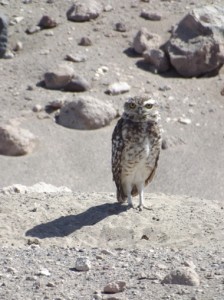
We arrived at the burial ground & disembarked. At first it appeared there was nothing there other than a few, what appeared to be, 4 legged bamboo roofed shades. Looking closer, the shades seemed to covered something underneath. Our guide started to explain…
The desert plains that we were on – & many like them all over Peru – were the homeland of many Inca & Pre Inca tribes in years gone by. They worshipped Mother Earth – the mountains, the sea, the rivers, the sun. Their burial grounds were on the same plains. Huge expanses of ceremonial burial grounds, the markations of which disappearing long ago. Some have been discovered, but one of the most significant is the Chauchilla burial ground.
The graves would have consisted of a small chamber dug in to the ground, rectangular in shape. They would have varied in size according to the number of people being buried there, but it’s logical to assume they would have had ‘family graves’, & some would have had more than one chamber, separated by a small wall. The open tops of the graves would have been covered with a lattice work of wood & vegetation before being covered over with earth. The depth of the graves would have been about 5ft & would have varied in size, but typically about 4ft by 3ft. The earth covering the grave would have been around 1ft. Some were slot larger than this, as you could tell by the size of impression they had left behind.
The burial ground was discovered in late late 80s/early 90s when grave robbers, having discovered the graves themselves, looted them. Graves that had lain undisturbed for 1000 years were ransacked in the hope of finding treasures or items of value. Hundreds of graves were ruined,t before they gave up their quest realising there was nothing of value to be taken. What the robbers hadn’t realised was that the graves were of simple people – mostly farmers probably – so all they found in the graves were pots, tools & other simple items.
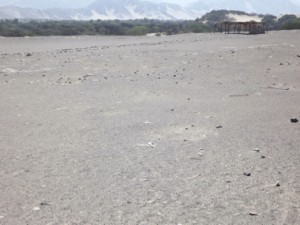
Because of the way the graves were left, a landscape that should have been flat was littered with large divets where the graves had collapsed beneath the surface. The way that the robbers had ruthlessly gone through each grave meant that much of the contents were destroyed & as wee looked closely at the ground before us literally thousands of bones were scattered all around in the sand. Although archeologists have visited the site to try to piece together the history of the site, there is no funding for the project so all the work at the site is by volunteers. Under the shades that I mentioned earlier were ‘reconstructions’ of what the graves would have originally looked like.
It’s hard to describe, but the photos speak many words. The bodies would all be buried facing east – the sun. The body would be placed in an almost foetal position – with the kneels up under the chin & the arms bent at their side. The body would then be wrapped firstly in wool, with any ‘gaps’ packed with wool too. The whole would then be wrapped in material but the head would be left protruding. This would then be the ‘bundle’ that would be placed vertically in the grave with various artefacts placed around it – pots (always in pairs for ‘balance’ with the earth), tools of the persons trade, shells. Some of the skulls we saw actually had hair attached, which was really weird.
The whole thing may sound really morbid to you guys reading this, but it was quite amazing to see – & to be standing there where a whole race of people would have stood, lived, farmed, existed & ultimately died & been buried. Quite amazing.
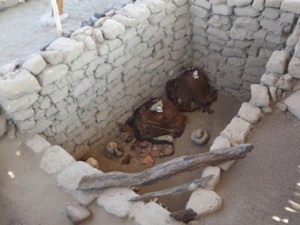

Amazed out – or so we thought – it was on to the small airport to board our plane to see the Nasca Lines. Just when we thought we could be amazed no more the Lines were presented to us.
If I were to details all the myths, legends, hypothesis, theories etc about the Lines, we would all be here a very long time, but let me explain – in brief – just what the Nasca Lines are. The Nasca Lines are a series of geoglyphs located in the Nasca Desert, a high arid plateau that stretches more than 50 miles between the towns of Nazca & Palpa on the Pampas de Jumana in Peru. Although some local geoglyphs resemble Paracas motifs, these are largely believed to have been created by the Nazca culture between 200BC & 700AD. The Lines consist of hundreds of individual figures, ranging in complexity from ‘simple’ lines to stylised hummingbirds, spiders, monkeys, fish, sharks, llamas and lizards.
The Lines are shallow designs in the ground where the reddish pebbles that cover the surrounding landscape have been removed, revealing the whitish earth underneath. In some designs the image is embossed as opposed to being in releif, but only a few.
The images remained undiscovered until the early 1920s during the building of the Pan American Highway when planes flying overhead first spotted them. Sadly, by the time they were discovered, the road had cut through 2 of them, but many trapezoids, thousands of geometric lines & 70 massive animal & plant figures remain intact. As the Lines are only truly visible from the air, a flight it had to be!
Most of us did it, but there were a few who didn’t fancy it. As we found out, it was to be a bit like a fairground ride & was only for those with very strong stomachs!
The plane was. 12 seated Sessner (please excuse me if I have spelt this wrong – planes have never been my strongpoint). It was small, very compact & you felt every bump. As we took of we could each see through the pilot’s windscreen – which took me back the last time I was in this position… landing at Lukla on the way to Everest Base Camp in Jan 2010… & I wasn’t sure whether I was excited about it or not!
However, all was well & we soon ascended to 2200m. Then the fun began. In order to see the Lines from the plane, it had to bank hard on its side. The plane then obviously turned in the direction of the bank, so once the plane had pulled level again it was the turn of the people sitting on the other side of the plane to see. This meant a really hard 180 degree bank to turn the plane around, then a further hard bank on its side so the other side could see. The effect this all had on the stomach was severe! Imagine a roller coaster, but faster & with much more g-force… you’re somewhere near!

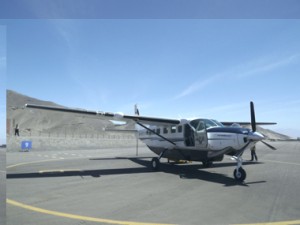
Ruth, bless her, was sat just behind me & sadly holding a sick bag & a camera as well as holding the bag open, getting her aim straight & getting the Lines in shot to take a picture just proved too much & she spent the entire flight hoooking. Poor thing – she looked really rough when she got off the plane. I’m not being cruel here, she really did – & I told her. I know she appreciated my honesty 🙂
As we waited fir the rest of our number to finish their flights, we watched as more people disembarked from their flights in various states of disarray. One Chinese lady had to be carried off, whilst a German lady staggered past us looking like she’d a few too many Pisco Sours as her husband scuttled timidly behind her clutching a selection of little bags…
From here we went to eat!
A great restaurant in the heart of Nazca – did you know it only rains there 2 or 3 times a year? Nazca – not the restaurant. When it does rain, they get about 20-30 minutes worth in total. That’s it! Amazing. As we sat eating our food we heard some music coming from downstairs – my ears instantly picked up the beat so I went to have a look. It was a 4 piece traditional Peruvian band playing (what looked like) a ukulele, a guitar, a set of blow pipes &… a cajon! I was dying to get my hands on the cajon – for this of you who don’t know it’s a percussion instrument made of wood & is effectively a box that you sit on. By hitting the sides of the cajon with cupped hands or the ends of your fingers you can get a great sound out of it – & play one!
They were great & I recorded them so I could listen to them again when I get home – & for some playing tips!
From the restaurant we went back to the hostel & spent the afternoon resting (or in my case blogging!) before heading off to the bus station for our 10 hour bus journey on to Arequipa. Leaving at 9:30pm, the bus would take us along the Pan American Highway all the way to the town. As we boarded & got ourselves bunked in, it all seemed very nice: there were 2 decks, each kitted out with television screens, comfortable reclining seats – reclining to about 60%, each seat had its own pillow & blanket, air con, window curtains… & so this list goes on.
However, the road wasn’t to be a straight one, in more ways then one…
Tune in to the next blog to find out more!
Gb 🙂
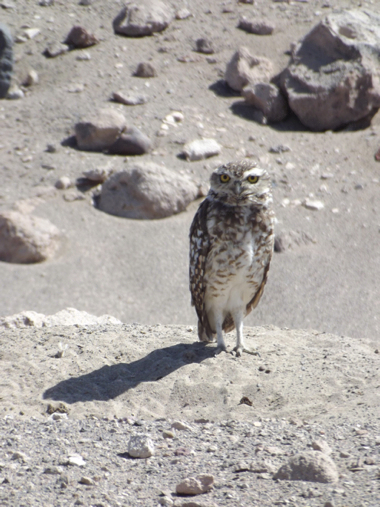
Awww wish I could have had a go on the ukulele!
Ooooh. Love the owl. Burrowing Owl?